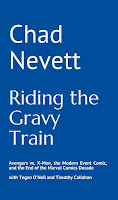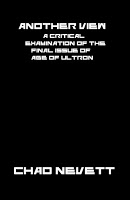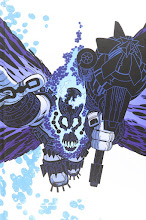Does Thor need a ‘secret identity?’
I understand that, in the Marvel Universe, the point is that it’s like our world, after a fashion. Most of the heroes are some version of a regular person, either given powers through an accident, the luck of genetics, or their own ingenuity and skill. Thor is the exception. He’s the god amongst mortals. To counterbalance this, when he was first introduced, it was as a transformation that Dr. Donald Blake underwent when he struck a specific stick against the ground. Blake, suffering from a disability in addition to a general frailty, was the opposite of Thor’s impressive physical skills. The nerd becomes the jock. Originally, Thor was Blake, retaining his mind after the transformation while gaining some innate awareness of Thor’s life and world. Gradually, over the course of a dozen or so issues, Blake’s influence as Thor lessened and Thor morphed into the version of the character we’re familiar with. While a link between the two remained, they became more like two separate people rather than a single mind housed in two different bodies that change places. After a period, Blake was so unimportant that you’d be forgiven if thinking he had been written out permanently.
As Jack Kirby’s influence over Thor grew, so too did the unearthly side of the character. Asgard was developed further, Thor went out into space, and Blake wouldn’t appear for an entire year at one point. The idea of a god as man faded in favour of the stories of a warrior god superhero. Donald Blake wasn’t much of a character and the initial love triangle between him, his alter ego, and his nurse Jane Foster didn’t exactly rival the Clark/Superman/Lois one. Kirby and Stan Lee pushed it as far as they could until it became just a Thor/Jane relationship and even that ran its course fairly quickly after she refused elevation to an immortal and joining Thor in Asgard. After that, Blake never went away, but he was no longer relevant unless a story specifically called for his presence. Unlike Spider-Man’s adventures which were driven by Peter Parker’s personal life often with his superheroing acting as another complication, Thor was the central focus and Blake was the distraction.
That is, until Walt Simonson took over Thor in 1983 and, in his first four issues, wrote Blake out. Already revealed long before as a creation of Odin meant to teach Thor a lesson in humility, Simonson clearly saw that the character was unnecessary baggage and used the enchantment that transformed Thor into Blake and vice versa, and gave it to his creation, Beta Ray Bill, allowing him to transform between his original form and his warrior form. It was the best use of Donald Blake in years. Simonson introduced a human alter ego for Thor, Sigurd Jarlson, which was really just the Asgardian with a ponytail and glasses, a gag built on the Superman/Clark change in appearance. Jarlson worked construction when the story called for it and it gave Thor something to do while on Earth, while also lacking the substance of an existing life that allowed for him to abandon it when needed. Jarlson was just a name and a look to allow Thor to make believe as human when it suited him. It was an acknowledgment that he didn’t need a human identity so much as wanted one, sometimes.
When Tom DeFalco and Ron Frenz followed Simonson on Thor, the first year to year and a half on the title had Thor maintain his Asgardian status quo. He fought Celestials and uncovered a scheme by the Egyptian God of Death, Seth, culminating in a huge confrontation that had both Odin and Surtur return. They also had Sigurd Jarlson return briefly and, in the process, introduced architect Eric Masterson. The architect of the building that Jarlson was working on, Masterson was a divorced single dad and didn’t jump out as anything more than a supporting character with a modern-for-the-1980s backstory. After the Seth story culminated, Masterson was kidnapped by the villainous Mongoose to draw out Thor, leading to a trip into space and, upon returning to Earth, a confrontation with Mongoose left Masterson close to death. Thor called upon Odin’s assistance and the All-Father tied to the life essence of both men together. Basically, Eric Masterson became the new Donald Blake.
That status quo of Thor and Eric sharing a life persisted until Thor seemingly killed Loki and was banished from existence by Heimdall (filling in for Odin). However, as the world still needed a Thor, he gave that power to Eric and, suddenly, Thor was actually a mortal human. Eric transformed into Thor ala Blake, but retained his mind in the godly body. He slowly learned how to be Thor, took the real Thor’s place in the Avengers, got mixed up in Asgardian schemes and, by the end of the DeFalco/Frenz run, brought the real Thor back. Originally given Mjolnir by the Asgardian to continue acting as him on Earth, that arrangement didn’t work and, instead, Masterson was given a less powerful mace dubbed Thunderstrike. While Thor continued on his comic, DeFalco and Frenz continued telling Eric’s story as Thunderstrike in his own title. Eric was the main character of the run despite not appearing in it for the first year.
This slow introduction and transition is one reason why my usual hesitancy about Thor having a human identity doesn’t come into play. DeFalco and Frenz take the transition in stages, telling regular Thor stories, adding Eric as a supporting character, then pairing him and Thor in what reads as an organic change for both and, then, when another story-driven change occurs, Eric takes over as Thor himself until, finally, transitioning to Thunderstrike. Each period is given a good amount of time and space so it doesn’t feel like a rush from one to next; and, at each change, it never feels arbitrary or forced. It’s all driven by story and character choices. Too often, the addition of a human identity, like Jake Olson or the returned Donald Blake, don’t work is because they’re dropped right into the story from the beginning with no build or reason save the desire of the writer. Eric, on the other hand, was able to linger in the background a little and feel like a small part of the comic before becoming the star. When he took over as Thor at the end of issue 432, it didn’t feel like he was pushing Thor out of his own story. Thor made a choice to kill Loki and faced the consequences of that action – the addition of Eric becoming the new Thor was the twist. There was no evil scheme in the plot to make a mortal the new Thor... it’s just what happened.
Eric as a character was more developed than ciphers like Blake and Olson. The former was literally revealed as an invention created by Odin, while the latter was given a sense of a larger life, but, as the reader was dropped into it with Thor, it had a harder time landing. It’s the difference between a brand new character taking over as opposed to an established character stepping up into a more prominent role. There’s a better sense of what you’re getting with an established character and the various new conflicts are logical ones, arising from already known factors. When Thor and Eric are merged, we know that Eric has a son and a will they/won’t they thing with both his assistant and his professional rival. Rather than those things complicating Thor’s life, Thor is the addition that complicates Eric’s already full life! And that last point is a subtle one that helps this status quo. Thor remains, largely, Thor and it’s Eric who suffers from suddenly having a godly alter ego. And we care about that!
Eric, more than simply fitting into the Marvel tradition of the regular guy whose life is complicated by his newfound powers, is positioned as the inverse of Thor. Thor is the headstrong son who does as he pleases, sometimes ignoring his responsibilities at home. Eric is the responsible father who increasingly finds himself dragged away from the responsibilities at home that he wants to be his priority. Prior to the union with Eric, DeFalco and Frenz’s Thor was also a fairly stripped back, basic version of the character. As much as I love the character, he can, sometimes, default into generic warrior hero, which is a reason why writers keep trying to make the human alter ego thing work. Again, this is one reason why giving Eric that role after 18 or so months was a smart choice. DeFalco and Frenz got as much mileage out of Thor solo as they could and changed things up before it got stale.
Eric provided depth and conflict (both internal and external) to Thor. While Thor remained the same do-good hero, he had a little voice inside his head that nagged him about Kevin Masterson or a blown deadline at work. Giving Thor some personal stakes in what happened on Earth was a benefit, particularly when Kevin was placed in harm’s way – or that Thor and Eric sharing a body gave a reason for Hercules to suddenly become Eric’s roommate. All of which is the broad goal of giving a character like Thor a human identity. Part of the problem with other human identities is that they either were paper thin (Blake), retreads of previous identities (Olson), or nostalgia wanks (Blake again). Eric succeeds, in no small part, because he isn’t like any other Thor identity. While meeting Thor and having his life saved by merging with Thor dramatically changes the course of his life, he had a life. That’s the point. Eric could have stayed a sometimes supporting character like Sigurd Jarlson’s boss Jerry Sapristi and been a great addition to the Thor comic as just that. His function outside of Thor’s alter ego makes placing him in that role additive.
Prior to taking over Thor, DeFalco and Frenz worked on Spider-Man and Eric is definitely a hero in the mould of Peter Parker. At a time where Peter was newly married and the idea that he may be settling into a life of juggling Spider-Man and a family, Eric was the matured, divorced single dad trying to make a go at being a hero. He showed how relatable an adult Peter Parker with adult problems could be (despite what many at Marvel would have you believe). In fact, I would argue that Eric’s best moment comes from being a father in Thor #421 when, after continual threats to Thor have put his son at risk, he gives up custody in the middle of a heated legal fight with his ex-wife. It’s the best four pages of the entire DeFalco and Frenz run, full of emotion and phenomenal storytelling by both men. Frenz composes his pages perfectly for maximum impact, while DeFalco chooses the words incredibly carefully, often opting to let silence and the art carry things. Eric’s decision to give up his son is heroism at his finest – unconditional love and self-sacrifice put into action better than almost any other example I can think of. It’s a choice that puts his son’s wellbeing above all else and is one that affects Eric until the end of Thunderstrike. It recalls Thor’s decision to share his life with Eric; not an easy sacrifice that is over and done immediately like laying down one’s life. It’s a hard choice with lasting consequences that must be lived with.
That decision to give up Kevin is also the moment that cements Eric as devoted to being a superhero. At several times, he’s given the chance to walk away. From the time that Thor is exiled and Eric is given the cane to transform into Thor, he always has the option to put it down and walk away. At first, he thinks he owes something to Thor, to take his place and, hopefully, find a way to bring him back. So, he does that – and, then, when Thor is returned, Eric is ready to keep Mjolnir at the Thunder God’s request. And when that is no longer a possibility, he accepts the gift of the enchanted mace and assumes the identity of Thunderstrike. Eric’s heroism is a choice. It may have began as the only way for him to survive a deadly encounter with Mongoose, but, pretty soon into that time, he begins making choice after choice to give up his own desires and any chance at a regular life to do good. He sacrifices his personal desires – living with his son, having a steady job, having a relationship – to be like the hero that saved his life.
Eric’s desire to be like Thor is yet another element that makes him so compelling as Thor’s alter ego and replacement. He isn’t Thor – he isn’t controlled by Thor or driven to do what Thor wants out of obligation or guilt. He is genuinely inspired by Thor and wants to be like him. He’s that guy who is saved by a hero and actually gets to make right on that debt – and he never stops trying. Eric’s time as the new Thor is one of continual humiliations and setbacks. He’s called a fourth-rate fake by pretty much everyone he encounters – he fails as often as he succeeds – and he keeps going. And does it his way. One of the best running subplots throughout the run is the way he gives Crusher Creel the Absorbing Man chance after chance to make a life away from crime. Something about Creel’s desire to settle down with Titania and live a quiet life gives Eric a blind spot for the villain. It immediately separates Eric from most heroes as he is always willing to talk things out and find a peaceful solution – a bit of a change from a hero who finds that everything looks like a nail to hit with his hammer.
Eric’s journey as a hero is one that leads him to becoming more and more like himself. He starts as the other side of Thor, then gets all of Thor’s power, and, then, loses that identity and some of the power to be the sort of hero he wants to be. It’s a downward slope in that he goes from Thor to replacement Thor to Thor knockoff, but each step allows him to shape the sort of hero he wants to be. Sharing a body with Thor, he’s more of a passenger than a driver; as Thor, he has a certain reputation and obligations to live up to; as Thunderstrike, he gets to decide what that identity means. The comic itself struggles in its first year to come to a decision and, while it makes for some uneven reading, when you look at it as part of the whole, there’s charm in watching both the character and creators cast about a little, trying to figure out what Eric’s idea of a superhero is.
What they all settle on is “THE EVERYMAN AVENGER” as becomes the tagline above the logo beginning with Thunderstrike #19. His struggles as an Avenger were pretty much legendary by this point, but he had grown into a respectable role within the team, often bringing that ‘average person’ perspective to things. He was cast in opposition to the stuffy, arrogant beaurocracy that could make the Avengers seem out of touch at the time. He was the guy who would gawk when he finds himself in the Shi’ar throne room or think outside of the usual hero box. It a role that other Avengers occupied before him (Hawkeye was great for being that voice of dissonance) and, by the time his book (and life) ended, he seemed to finally be getting the hang of it.
Even Eric’s death was a choice. Faced with the returned threat of Seth (DeFalco and Frenz going back to the beginning of their run), he made a choice to take up Bloodaxe and give himself over to its power to ensure he would be able to stop the Egyptian god. He knew that it was a dangerous move that he may not come back from – and he didn’t. What it also showed was the trust he put in his hero, Thor, to step in and put him down if it needed to be done. Those final two issues of Thunderstrike show that, even though Eric grew into the role of a seasoned hero, he never lost those defining characteristics that he had from the beginning. He never stopped choosing to be a hero no matter the cost; and he never lost faith in the hero that saved his life and acted as a constant inspiration.
If there’s one thing that Jason Aaron took from this run, it was making Jane Foster loving being Thor... just as Eric did. He was so easy to root for and see yourself in, because, like those of us reading Thor comics, he looked up to the Thunder God. He was the everyman Thor.








